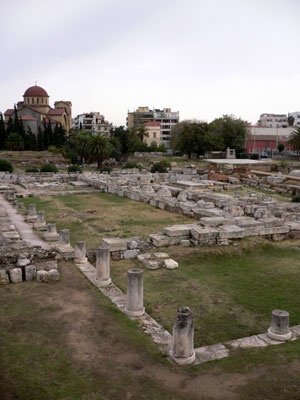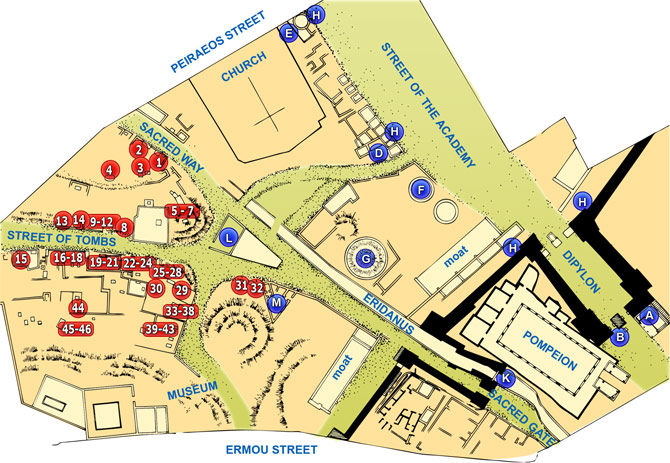
Kerameikos Athens
Kerameikos is one of the most ancient districts of Athens. The name comes from the Greek word keramos meaning roof-tile, an obvious allusion to the many tile-makers' and potters' quarters established there from the earliest times.
It will be remembered that after the victory over the Persians at Plataea in 479 BC, Themistocles ordered the building of massive defense walls around Athens and Piraeus. At the conclusion of the Peloponnesian War (404 BC), the walls were demolished by the victorious Spartans, but were restored by Conon in 393 BC and reconstructed some sixty years later. The Roman general Sulla finally razed them in 86 BC. A section of the walls passed through the Kerameikos and divided the district into two sectors: the Inner, which included the agora, the principle administrative and judicial buildings, and the potters' and smiths' quarters, and the Outer Kerameikos in which lay the necropolis.
The Hellenic peoples regarded the interment of the dead as one of the most sacred duties. In war, the obligation to bury the enemy dead, whether Hellene or barbarian, was equally binding. Since it was believed that the presence of corpses brought pollution to the living, bodies were either cremated or inhumed far from the city walls, usually at the side of main roads or outside the gates of the city; the evolution of the Kerameikos extra muros of the sixth century BC can be traced to the observance of this hygienic precaution. Archaeological evidence found during excavations in the area shows that the Outer Kerameikos was already in use as a burial ground as long ago as the 12th century BC.
Kerameikos Map

DIPYLON
A. Fountain House
B. Altar of Zeus
C. Tower with remains of the Themistoclean gate
KERAMEIKOS PUBLIC TOMBS
D. Tomb of the Lacedaemonians
E. Public Tomb of an unknown
F. Baths
G. Round monument
SACRED GATE
I. Small gate
K. Tower with arch
OUTSIDE OF THE SACRED GATE
L. Sanctuary of the Tritopatreis
M. Sanctuary of an unidentified deity
1,2. Family Tombs on the Sacred Way
3. Loutrophoros of Olympichos
4. Grave Tumulus of Eucoline
5-30. Family Tombs on the Street of Tombs
31,32. Ambassadors Tombs
33-46. Family Tombs on the Southern Way
